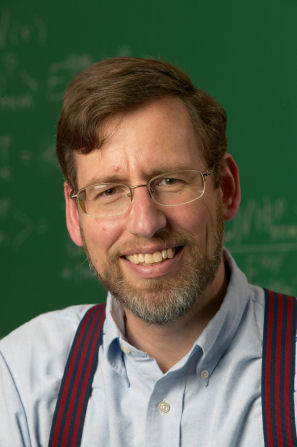 Lawrence WEINSTEIN
Lawrence WEINSTEIN Lawrence WEINSTEIN
Lawrence WEINSTEIN Mailing Address: Department of Physics
Old Dominion University
Norfolk, VA 23529
Phone: (757) 683-5803
Research Location: ODU/ Jefferson Lab
Research Sponsor: US Department of Energy (DOE)
E-mail: my_last_name at odu.eduMy research consists of studying how nucleons (protons and neutrons) interact to form nuclei. I do this like a five-year-old: hit it hard and see what comes out. In this case I hit the nucleus with a high energy electron and detect the scattered electron and one or more of the knocked out protons [which is abbreviated (e,e'p)]. I do most of my experiments at Jefferson Lab (formerly known as CEBAF) in Newport News, Virginia, just 30 minutes from ODU. In order to help build Jefferson Lab, the ODU Nuclear Physics Group has designed, prototyped, built, installed and tested the large Region II Drift Chambers (particle detectors) for the CEBAF Large Acceptance Spectrometer (CLAS).
There are two opposing views of the nucleus that I refer to as the 'bag of marbles model' and the 'water balloon model'. In the bag of marbles model, the nucleons (protons and neutrons) in the nucleus are whizzing around like marbles in a vigorously shaken bag. The nucleons do not affect each other much except (briefly) when they collide. If you shoot one of the marbles out of the bag or knock one of the nucleons out of the nucleus, the others do not really notice. This is a grossly oversimplified version of the independent particle model of the nucleus. In the water balloon model, the nucleons are strongly correlated and if you shoot the nucleus, it goes splat like a water balloon. This is a grossly oversimplified version of the correlations model. The real nucleus is, of course, a mixture of the two models.
I am interested in the correlations between nucleons. Current theories of the nucleus, which describe nucleons as separate, independent objects, can only explain about 60% of the (e,e'p) experimental results. We know that nucleons in nuclei are strongly-interacting extended-objects that overlap each other about 40% of the time. We know that 40% of the time more than one nucleon is knocked-out from the nucleus when you hit it with an electron. We do not know many details about this multinucleon knockout, either experimentally or theoretically. There is also no basic theory of what a proton is when it is in the nucleus. Understanding how nucleons behave when they overlap will help significantly to understand how three quarks combine to make a nucleon.
I have two approved experiments at Jefferson Lab to study this problem. The first experiment (E00-102), in Hall A, uses O(e,e'p) to study the momentum distribution of the protons in the nucleus to see the effects of correlations with other nucleons. The first phase ran in summer 1997 and the results are published. The second phase ran in Fall 2001. The second experiment (E89-027) uses the CEBAF Large Acceptance Spectrometer (CLAS) to study (e,e'X), that is to study everything that gets knocked out of the nucleus during electron scattering. This will let us study all of the correlations between ejected charged particles in these reactions and greatly improve our knowledge of these reactions. This experiment took data in early 1999 and in Spring 2002 and is currently under analysis. I am concentrating on reactions where all three nucleons are knocked out of 3Helium at high speed. We appear to have measured independent pairs of nucleons by hitting the third nucleon in 3Helium and detecting the spectator pair. Here is the press release (8/29/03). See the recent conference proceedings (under publications) for more details. A cartoon of a typical interaction can be seen here (25 kB).
Working with the Old Dominion Nuclear Physics group at Jefferson Lab is an excellent opportunity to get involved with one of the world's best nuclear physics laboratories.
Last modified: June 2011 MET